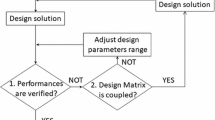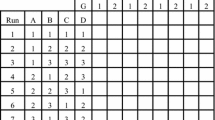Abstract
The paper discusses a generic procedure for the parameter design of product and process development using planned and non-planned experiments. The method can predict the system sensitivity (robustness) against the stochastic stressful noises (e.g., unit-to-unit, stochastic chocks, environmental variation) and the non-natural sources of variation explaining the inability of the developed product/process to achieve its optimal functionality, beyond the pure random disturbances. The intrinsic and the extrinsic insensitivity components are isolated and evaluated using the stochastic frontier production methodology. The Cobb-Douglas and the TransLog, two accepted functional forms for the stochastic frontier model, are used to check the sample data adequacy and predictability. Hypothesis tests regarding the magnitude and the direction of the intrinsic and the extrinsic robustness components, the distributional form of the extrinsic insensitivity, and the estimation of the stochastic frontier parameters are performed using the maximum likelihood estimator. Finally, for the sake of completeness and applicability, the method has been demonstrated using three industrial case studies.








Similar content being viewed by others
Abbreviations
- CD:
-
Cobb-Douglas
- CRS:
-
Constant Return to Scale
- DFSS:
-
Design for Six Sigma
- DMU:
-
Decision Making Unit
- DRS:
-
Decreasing Return to Scale
- ENI:
-
Extrinsic Noise Insensitivity
- INI:
-
Intrinsic Noise Insensitivity
- IRS:
-
Increasing Return to Scale
- LR-statistic:
-
Log Ratio-statistic
- LTB:
-
the ‘Larger is The Better’
- ML:
-
Maximum Likelihood
- NTB:
-
the ‘Nominal is The Better’
- OLS:
-
Ordinary Least Square
- PCH:
-
Performance CHaracteristic
- SF:
-
Stochastic Frontier
- S/N:
-
Signal to Noise ratio
- STB:
-
the ‘Smaller is The Better
- STI:
-
System Total Insensitivity
- TE:
-
Technical inEfficiency
- TL:
-
TransLog
- VRS:
-
Varying Return to Scale
References
Kwaka YH, Anbari FT (2006) Benefits, obstacles, and future of six sigma approach. Technovation 26:708–715. https://doi.org/10.1016/j.technovation.2004.10.003
Pyzdek T, Keller PA (2010) “The six sigma handbook”, a complete guide for green belts, black belts, and managers at all levels, 3rd edn. McGraw-Hill, New York
Lee MC, Chang T (2010) Developing a lean design for Six Sigma through supply chain methodology. Int J Prod Qual Manag 6(4):407–434. https://doi.org/10.1504/IJPQM.2010.035891
Ferryanto L (2007) Design for six sigma. Jurnal Teknik Industri 9(1):1–14
Maghsoodloo S, Ozdemir G, Jordan V, Huang CH (2004) Strengths and limitations of Taguchi’s contributions to quality, manufacturing, and process engineering. J Manuf Syst 23(2):73–126. https://doi.org/10.1016/S0278-6125(05)00004-X
Creveling CM (1997) Tolerance design: a handbook for developing optimal specifications. Addison-Wesley, Reading
Unal R, Dean EB (1991) Taguchi approach to design optimization for quality and cost: an overview. Annual Conference of the International Society of Parametric Analysts
Nair VN, Abraham B, MacKay J, Box G, Kacker RN, Lorenzen TJ, Lucas JM, Myers RH, Vining GG, Nelder JA, Phadke MS, Sacks J, Welch WJ, Shoemaker AC, Tsui KL, Taguchi S, Wu CFJ (1992) Taguchi’s parameter design: a panel discussion. Technometrics 34(2):127–161. https://doi.org/10.1080/00401706.1992.10484904
Tsui KL (1992) An overview of Taguchi method and newly developed statistical methods for robust design. IIE Trans 24(5):44–57. https://doi.org/10.1080/07408179208964244
Karna SK, Sahai R (2012) An overview on Taguchi method. Int J Eng Math Sci 1(1):1–7
Ghani JA, Jamaluddin H, Ab. Rahman MN, Deros BM (2013) Philosophy of Taguchi approach and method in design of experiment. Asian J Sci Res 6(1):27–37. https://doi.org/10.3923/ajsr.2013.27.37
Brenneman WA, Myers WR (2003) Robust parameter design with categorical noise variables. J Qual Technol 35(4):335–341. https://doi.org/10.1080/00224065.2003.11980231
Clemson B, Tang Y, Pyne J, Unal R (1995) Efficient methods for sensitivity analysis. Syst Dyn Rev 11(1):31–49
Terninko J, Zusman A, Zlotin B (1998) Systematic innovation, introduction to TRIZ (Theory of Inventive Problem Solving). CRC Press, Taylor & Francis Group Edition
Salamatov Y (1999) The right solution at the right time: a guide to innovative problem solving. Sample Chapter. Published by Insytec B.V, The Netherlands
Pugh S (1987) Design decision- how to succeed and know why. Concept Selection (Accession no. X8700381) Design Institute, Xerox Corporation.
Dieter GE, Schmidt LC (2009) Engineering design, 4th edn. McGraw-Hill, New York
Mill H (1994) Enhanced quality functional deployment. World Class Des Manuf 1(3):23–26. https://doi.org/10.1108/09642369210056610
Witter J, Clausing D, Laufenberg L, De Andrade RS (1995) Reusability – the key to corporate agility: its integration with enhanced quality function deployment. World Class Des Manuf 2(1):25–33. https://doi.org/10.1108/09642369310077742
Fowlkes WY, Creveling CM (1995) Engineering methods for robust product design: using Taguchi methods in technology and product development. Addison-Wesley, Reading
Griffin A, Hauser JR (1993) The voice of the customer. Market Sci 12(1):1–27. https://doi.org/10.1287/mksc.12.1.1
Smith JS (2003) Survey on the use of simulation for manufacturing system design and operation. J Manuf Syst 22(2):157–171. https://doi.org/10.1016/S0278-6125(03)90013-6
De Werra D (1987) Design and operation of flexible manufacturing systems: the kingdom of heuristic methods. RAIRO Recherche Opérationnelle 21(4):365–382
Negahban A, Smith JS (2014) Simulation for manufacturing system design and operation: literature review and analysis. J Manuf Syst 33:241–261. https://doi.org/10.1016/j.jmsy.2013.12.007
Luo L, Kannan PK, Besharati B, Azarm S (2005) Design of robust new products under variability: marketing meets design. J Prod Innov Manag 22(2):177–192. https://doi.org/10.1111/j.0737-6782.2005.00113.x
Kromrey JD, Hines CV (1996) Estimating the coefficient of cross-validity in multiple regression: a comparison of analytical and empirical methods. J Exp Educ 64(3):240–266. https://doi.org/10.1080/00220973.1996.9943806
Yin P, Fan X (2001) Estimating R2 shrinkage in multiple regression: a comparison of different analytical methods. J Exp Educ 69(2):203–224 http://www.jstor.org/stable/20152659
Box GEP, Fung CA (1986) Studies in quality improvement: minimizing transmitted variation by parameter design. CQPI Reports (Report no. 8)
Bisgaard S (1992) A comparative analysis of the performance of Taguchi’s linear graphs. CQPI Reports (Report no. 82)
Montgomery DC (1997) Design and analysis of experiments, 4th edn. Wiley, New York
Lewis SM, Dean AM (2011) Detection of interactions in experiments on large numbers of factors. J R Stat Soc Ser B 63(4):633–672 https://www.jstor.org/stable/2680658
Li X, Sudarsanam N, Frey DD (2006) Regularities in data from factorial experiments. Wiley Period Inc Complex 11(5):32–45. https://doi.org/10.1002/cplx.20123
Tanco M, Viles E, Pozueta L (2008) Are all designs of experiments approaches suitable for your company? Proceedings of the World Congress on Engineering Vol II, WCE2008, London, UK, July 2-4
Frey DD, Jugulum R (2006) The mechanisms by which adaptive one-factor-at-a-time experimentation leads to improvement. ASME J Mech Des 128:1050–1060. https://doi.org/10.1115/1.2216733
Kacker RN, Lagergren ES, Filliben JJ (1991) Taguchi’s orthogonal arrays are classical designs of experiments. J Res Natl Inst Stand Technol 96(5):577–591. https://doi.org/10.6028/jres.096.034
Xu H, Cheng SW, Wu SFJ (2004) Optimal projective three-level designs for factor screening and interaction detection. Technometrics 46(3):280–292 http://www.jstor.org/stable/25470843
Leon RV, Shoemaker AC, Kacker RN (1987) Performance measures independent of adjustment: an explanation and extension of Taguchi’s signal-to-noise ratios. Technometrics 29(3):253–265. https://doi.org/10.1080/00401706.1987.10488231
Box GEP (1988) Signal-to-noise ratios, performance criteria, and transformations. Technometrics 30(1):1–40. https://doi.org/10.1080/00401706.1988.10488313
Nishimizu M, Page JM (1982) Total factor productivity growth, technological progress and technical efficiency change: dimensions of productivity change in Yugoslavia 1965-78. Econ J 92(368):920–936. https://doi.org/10.2307/2232675
Aigner DJ, Lovell CAK, Schmidt P (1977) Formulation and estimation of stochastic frontier production function models. J Econ 6:21–37. https://doi.org/10.1016/0304-4076(77)90052-5
Meeusen W, Van Den Broeck J (1977) Efficiency estimation from Cobb-Douglas production functions with composed error. Int Econ Rev 18(2):435–444 http://www.jstor.org/stable/2525757
Schmidt P, Lovell CAK (1980) Estimating stochastic production and cost frontiers when technical and allocative inefficiency are correlated. J Econ 13:83–100. https://doi.org/10.1016/0304-4076(80)90044-5
Coelli TJ, Rao DSP, O’Donnell CJ, Battese G (2005) An introduction to efficiency and productivity analysis, 2nd edn. Springer
Farrell MJ (1957) The measurement of productive efficiency. J R Stat Soc Ser A 120(3):253–290 https://www.jstor.org/stable/2343100
Gong BH, Sickles RC (1992) Finite sample evidence on the performance of stochastic frontiers and data envelopment analysis using panel data. J Econ 51:259–284. https://doi.org/10.1016/0304-4076(92)90038-S
Aigner DJ, Chu SF (1968) On estimating the industry production function. Am Econ Rev 58:826–839
Bravo-Ureta BE, Solis D, Moreira Lopez VH, Maripani JF, Thiam A, Rivas T (2007) Technical efficiency in farming: a meta-regression analysis. J Prod Anal 27:57–72. https://doi.org/10.1007/s11123-006-0025-3
Cooper WW, Seiford LM, Tonne K (2007) Data envelopment analysis: a comprehensive text with models, applications, references and DEA-solver software, 2nd edn. Springer
Timmer CP (1971) Using a probabilistic frontier function to measure technical efficiency. J Polit Econ 79(4):776–794 http://www.jstor.org/stable/1830828
Afriat S (1972) Efficiency estimation of production functions. Int Econ Rev 13:568–598. https://doi.org/10.2307/2525845
Chakraborty K, Biswas B, Lewis WC (1999) Technical efficiency in stochastic production frontier: a simultaneous equation approach. Economic Research Institute Study Papers (Paper 160) 10:1-33. https://digitalcommons.usu.edu/eri/160
Battese GE, Coelli TJ (1988) Prediction of firm-level technical efficiencies with a generalized frontier production function and panel data. J Econ 38:387–399. https://doi.org/10.1016/0304-4076(88)90053-X
Battese GE, Coelli TJ (1992) Frontier production function, technical efficiency and panel data: with application to paddy farmers in India. J Prod Anal 3:153–169
Battese GE, Coelli TJ (1995) A model of technical inefficiency effects in a stochastic frontier production function for panel data. Empir Econ 20:325–332
Kumbhakar SC, Lovell CAK (2000) Stochastic frontier analysis. Cambridge University Press, New York. https://doi.org/10.1017/CBO9781139174411
Coelli T (1995) Estimators and Hypothesis tests for a stochastic frontier function: a Monte Carlo analysis. J Prod Anal 6(3):247–268. https://doi.org/10.1007/BF01076978
Cornwell C, Schmidt P (1996) Production frontiers and efficiency measurement. In: Matyas L, Sevestre P (eds) The econometrics of panel data. Advanced studies in theoretical and applied econometrics, vol 33. Springer, pp 845–878, Dordrecht. https://doi.org/10.1007/978-94-009-0137-7_33
Greene WH (1980) On the estimation of a flexible Frontier Production model. J Econ 13:101–115. https://doi.org/10.1016/0304-4076(80)90045-7
Koop G (2001) Cross-sectoral patterns of efficiency and technological change in manufacturing. Int Econ Rev 42(1):73–103. https://doi.org/10.1111/1468-2354.00101
Battese GE, Cora GS (1977) Estimation of a production frontier model: with application to pastoral zone of Eastern Australia. Aust J Agric Econ 21(3):167–179. https://doi.org/10.1111/j.1467-8489.1977.tb00204.x
Mistree F, Lautenschlager U, Erikstad SO, Allen JK (1993) Simulation reduction using the Taguchi method. NASA Contractor Report CR 93-4542
Coelli T (1996) A guide to FRONTIER Version 4.1: a computer program for stochastic frontier production and cost function estimation. Centre for Efficiency and Productivity Analysis, University of New England, Armidale, Australia
Montgomery DC (2005) Design and analysis of experiments, 6th edn. Wiley, New York
Subhashchandra PR, Behnam B (2006) Prediction of variation in dimensional tolerance due to sheet metal hydroforming using finite element analysis. SAE Trans (J Aerospace) 115(1):563–567 https://www.jstor.org/stable/44657712
Acknowledgments
The authors would like to thank the IJAMPT editor and the anonymous reviewers for the contribution they made to this article.
Author information
Authors and Affiliations
Corresponding author
Additional information
Publisher’s note
Springer Nature remains neutral with regard to jurisdictional claims in published maps and institutional affiliations.
Rights and permissions
About this article
Cite this article
Trabelsi, A., Rezgui, M.A. Robust design of processes and products using the mathematics of the stochastic frontier (SF). Int J Adv Manuf Technol 106, 2829–2841 (2020). https://doi.org/10.1007/s00170-019-04503-6
Received:
Accepted:
Published:
Issue Date:
DOI: https://doi.org/10.1007/s00170-019-04503-6




